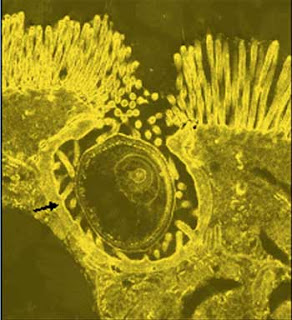
Burmese python, Python molurus bivittatus
Robert Pope, a researcher at Indiana University South Bend and Jean-Herv/(c) Lignot from Louis Pasteur University in France have discovered a new type of cell--found only in the Burmese python's stomach--that helps the animal survive on only a few meals a year. A Burmese python, which can grow to more than 20 feet long, often eats twice its body weight in a single sitting. The snake takes down its food quickly, but the newly discovered cells, named pit cells by Pope and Lignot, allow the snake to absorb even the calcium from the bones of its prey.
The pit cells are "long and bendy" and wind from outside the intestine to the inside surface where they create small holes or pits. Spherical bone particles collect in the pits and neighboring cells fold over the top, trapping the particles inside for digestion. Pope says the pit cells are designed to allow the snakes to ,Aeudigest as much calcium as they can while they are digesting prey.,Aeu

The arrow points to a spherical bone cell trapped in a python's pit cell
New types of cells are not a common find...Upon hearing of this fascinating discovery, Nicole Richie was reported as saying, "I've only eaten two Wow-Cow ice cream cones in the past 6 months. What's the big deal?"




